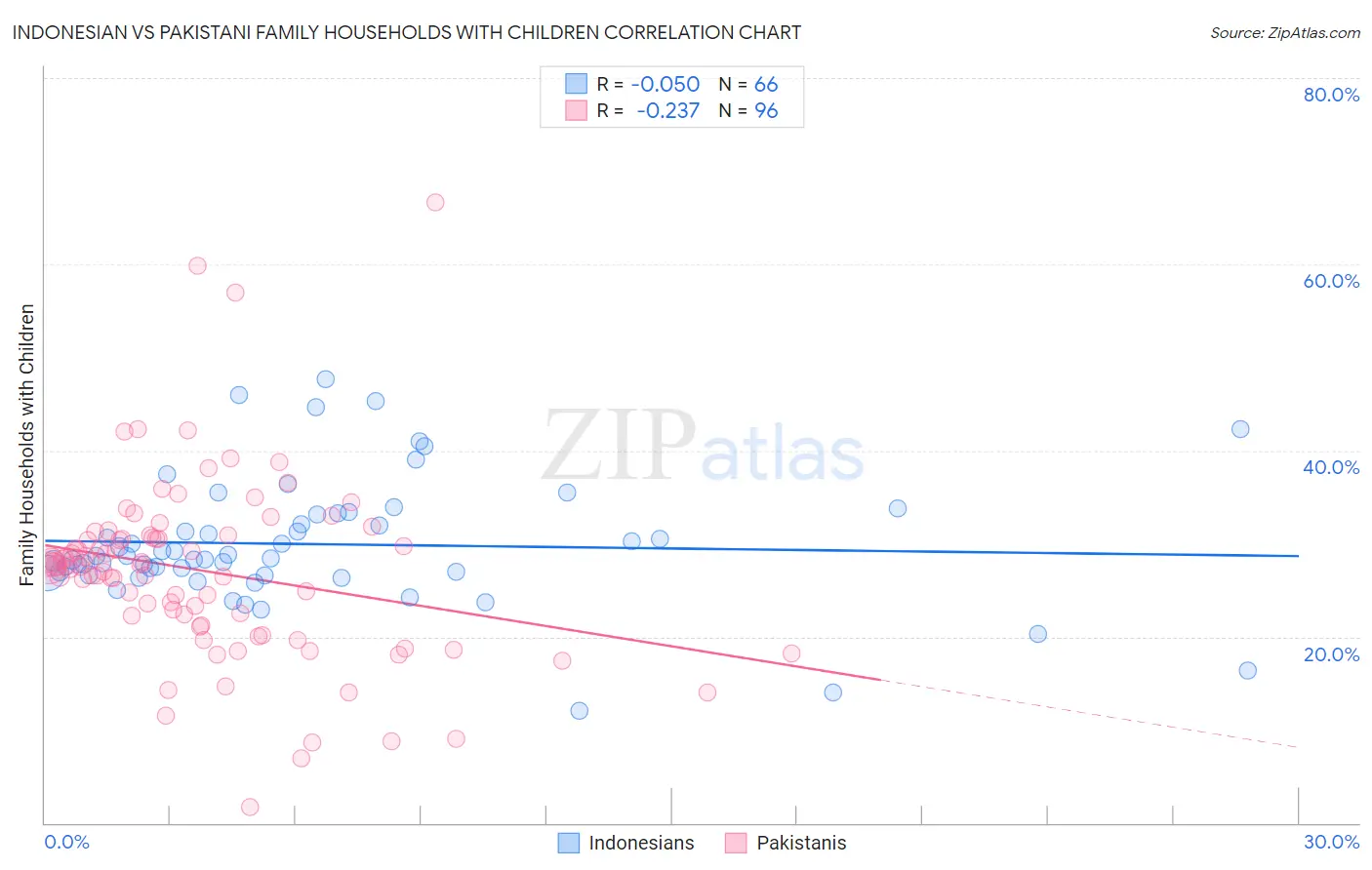Indonesian vs Pakistani Family Households with Children
COMPARE
Indonesian
Pakistani
Family Households with Children
Family Households with Children Comparison
Indonesians
Pakistanis
28.1%
FAMILY HOUSEHOLDS WITH CHILDREN
98.8/ 100
METRIC RATING
100th/ 347
METRIC RANK
27.9%
FAMILY HOUSEHOLDS WITH CHILDREN
96.0/ 100
METRIC RATING
116th/ 347
METRIC RANK
Indonesian vs Pakistani Family Households with Children Correlation Chart
The statistical analysis conducted on geographies consisting of 162,603,576 people shows a slight negative correlation between the proportion of Indonesians and percentage of family households with children in the United States with a correlation coefficient (R) of -0.050 and weighted average of 28.1%. Similarly, the statistical analysis conducted on geographies consisting of 335,080,458 people shows a weak negative correlation between the proportion of Pakistanis and percentage of family households with children in the United States with a correlation coefficient (R) of -0.237 and weighted average of 27.9%, a difference of 0.68%.

Family Households with Children Correlation Summary
| Measurement | Indonesian | Pakistani |
| Minimum | 12.1% | 1.7% |
| Maximum | 47.7% | 66.6% |
| Range | 35.6% | 64.9% |
| Mean | 29.9% | 27.1% |
| Median | 28.5% | 27.7% |
| Interquartile 25% (IQ1) | 26.8% | 21.8% |
| Interquartile 75% (IQ3) | 33.2% | 30.7% |
| Interquartile Range (IQR) | 6.4% | 9.0% |
| Standard Deviation (Sample) | 6.8% | 9.9% |
| Standard Deviation (Population) | 6.7% | 9.9% |
Demographics Similar to Indonesians and Pakistanis by Family Households with Children
In terms of family households with children, the demographic groups most similar to Indonesians are Immigrants from the Azores (28.1%, a difference of 0.0%), Immigrants from Kenya (28.1%, a difference of 0.010%), Immigrants from Oceania (28.1%, a difference of 0.020%), Assyrian/Chaldean/Syriac (28.1%, a difference of 0.050%), and Palestinian (28.1%, a difference of 0.15%). Similarly, the demographic groups most similar to Pakistanis are Immigrants from Malaysia (27.9%, a difference of 0.010%), Central American Indian (27.9%, a difference of 0.010%), Immigrants from Africa (28.0%, a difference of 0.13%), South American Indian (28.0%, a difference of 0.14%), and Arab (28.0%, a difference of 0.16%).
| Demographics | Rating | Rank | Family Households with Children |
| Immigrants | Kenya | 98.9 /100 | #98 | Exceptional 28.1% |
| Immigrants | Azores | 98.8 /100 | #99 | Exceptional 28.1% |
| Indonesians | 98.8 /100 | #100 | Exceptional 28.1% |
| Immigrants | Oceania | 98.8 /100 | #101 | Exceptional 28.1% |
| Assyrians/Chaldeans/Syriacs | 98.7 /100 | #102 | Exceptional 28.1% |
| Palestinians | 98.5 /100 | #103 | Exceptional 28.1% |
| Sioux | 98.3 /100 | #104 | Exceptional 28.1% |
| Choctaw | 98.3 /100 | #105 | Exceptional 28.1% |
| Immigrants | South America | 98.0 /100 | #106 | Exceptional 28.0% |
| Immigrants | Uganda | 97.7 /100 | #107 | Exceptional 28.0% |
| Immigrants | Burma/Myanmar | 97.7 /100 | #108 | Exceptional 28.0% |
| Tohono O'odham | 97.6 /100 | #109 | Exceptional 28.0% |
| Spaniards | 97.4 /100 | #110 | Exceptional 28.0% |
| Scandinavians | 97.1 /100 | #111 | Exceptional 28.0% |
| Immigrants | Middle Africa | 97.0 /100 | #112 | Exceptional 28.0% |
| Arabs | 97.0 /100 | #113 | Exceptional 28.0% |
| South American Indians | 96.9 /100 | #114 | Exceptional 28.0% |
| Immigrants | Africa | 96.8 /100 | #115 | Exceptional 28.0% |
| Pakistanis | 96.0 /100 | #116 | Exceptional 27.9% |
| Immigrants | Malaysia | 95.9 /100 | #117 | Exceptional 27.9% |
| Central American Indians | 95.9 /100 | #118 | Exceptional 27.9% |